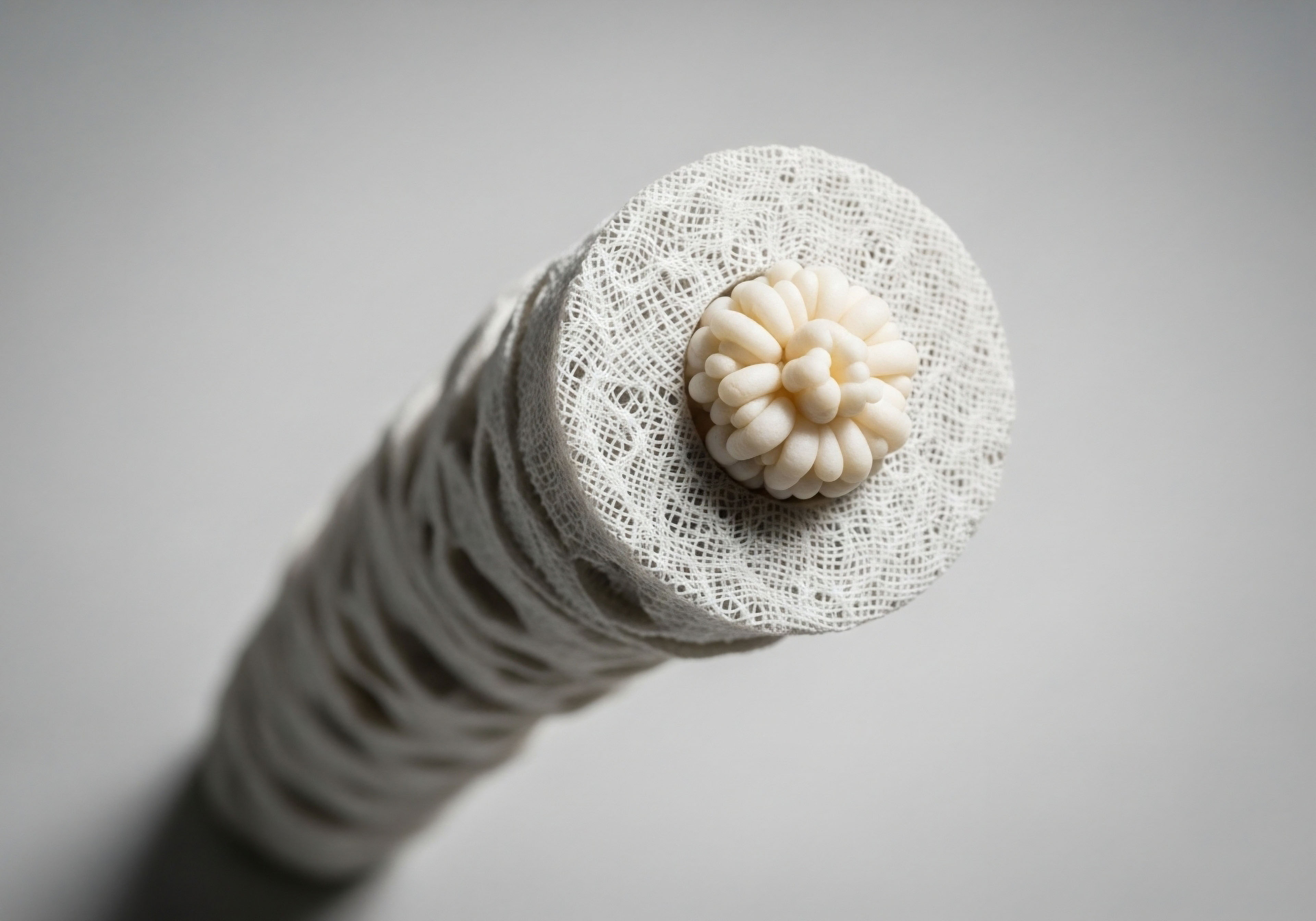

The Obsolescence of Default Biology
You are operating on a biological script written for a world that no longer exists. This script, honed over millennia, is programmed for survival and reproduction, after which its directives become secondary. The gradual decline in cellular efficiency, the slowing of repair mechanisms, the fading metabolic fire ∞ these are features of the original operating system.
This is passive aging. It is the body executing its default programming with predictable, systemic consequences. A different potential exists, one that shifts the operator from a passenger to the architect of their own biological machinery.
This emerging paradigm is built upon a foundation of active biological orchestration. It views the body as a high-performance system that responds to precise inputs. The language of this control system is biochemistry, and its most eloquent communicators are peptides. These short-chain amino acids are the functional currency of cellular communication.
They are molecular directives, carrying explicit instructions to targeted cellular receptors, instructing them on tasks from tissue reconstruction to metabolic regulation. Accessing these protocols is akin to gaining administrative rights to your own biology, allowing for a fundamental recalibration of the processes that define vitality and resilience.
The concentration of the human copper peptide GHK-Cu in plasma is around 200 ng/mL at age 20, but drops to 80 ng/mL by age 60, coinciding with a marked decline in the body’s regenerative capacity.
The acceptance of a predetermined biological trajectory is becoming a relic of a previous era. The new vanguard of personal performance understands that the human body is a dynamic, responsive architecture. Introducing specific peptide protocols is a method of updating the system’s core instructions. It is a direct intervention, supplying the cellular workforce with the blueprints and commands required to execute functions with youthful precision. This is the transition from passively observing age-related changes to actively directing cellular destiny.


Recalibrating the System Architecture
Peptide protocols function as a series of targeted software updates for your cellular hardware. Each peptide is a unique string of code, designed to interface with a specific biological pathway. Administration of these peptides delivers a set of instructions that your body’s cells are primed to receive and execute.
This process does not introduce foreign machinery; it reactivates and optimizes the body’s innate systems. The objective is to restore the precision of the body’s own signaling networks, commissioning cellular actions that define peak performance and structural integrity.
The architecture of human vitality is complex, governed by interconnected systems responsible for growth, repair, and defense. Peptides provide a way to address these systems with unparalleled specificity. One protocol might dispatch a command to rebuild connective tissue, while another recalibrates the hormonal cascade that governs energy and body composition. This is the essence of biological engineering ∞ using the body’s own language to issue clear, potent, and targeted directives.

System Integrity and Repair
The body’s capacity for self-repair is fundamental to its longevity and performance. Certain peptides are master regulators of this process. Body Protection Compound 157, or BPC-157, is a gastric peptide that has demonstrated a powerful systemic influence on tissue regeneration in preclinical studies. Its primary directive appears to be the acceleration of healing.
BPC-157 functions by initiating a cascade of repair mechanisms. One of its most documented effects is the promotion of angiogenesis, the formation of new blood vessels. This action enhances the delivery of oxygen and nutrients to damaged sites, which is a foundational requirement for any reconstructive process.
Animal models show its administration speeds the healing of muscle, tendon, and ligament injuries, tissues that are notoriously slow to mend due to limited blood flow. It appears to orchestrate the body’s entire repair crew, from upregulating growth hormone receptors on fibroblasts to modulating neurotransmitter activity, contributing to a more organized and rapid restoration of tissue integrity.

The Growth Axis Reboot
A decline in growth hormone (GH) is a central biomarker of aging. This master hormone, released in pulses by the pituitary gland, governs body composition, cellular regeneration, and metabolic rate. Growth Hormone Secretagogues (GHSs) are a class of peptides that directly interface with this system. They function by stimulating the pituitary gland to produce and release the body’s own endogenous growth hormone.
This is a critical distinction. The protocol is not supplying an external hormone; it is restoring the efficiency of the original production line. Peptides like Sermorelin and CJC-1295 are GHRH analogs, meaning they mimic the body’s natural signal for GH release. This restores a more youthful pattern of hormonal secretion, which in turn influences countless downstream processes.
The result is a systemic shift towards improved lean muscle mass, reduced adipose tissue, and enhanced recovery, all driven by the body’s own recalibrated machinery.
- Signaling Peptides (GHSs) ∞ Compounds like Sermorelin, Tesamorelin, and CJC-1295 act on the pituitary to amplify natural growth hormone pulses, influencing metabolism and body composition.
- Repair and Regeneration Peptides ∞ BPC-157 and TB-500 operate systemically to accelerate the healing of connective tissues, muscles, and the intestinal lining by promoting blood flow and cellular repair.
- Dermal and Aesthetic Peptides ∞ GHK-Cu directs skin fibroblasts to synthesize new collagen and elastin, improving skin density, firmness, and appearance.

Cellular Aesthetics and Dermal Remodeling
The skin is the most visible interface of our biology, and its appearance is a direct reflection of cellular health. The peptide GHK-Cu is a cornerstone of dermal optimization. This copper-binding peptide is naturally present in human plasma, but its levels decline sharply with age. Reintroducing GHK-Cu topically provides the skin’s cellular architects with a critical raw material and a powerful directive.
Clinical studies demonstrate that GHK-Cu initiates the synthesis of collagen and elastin, the core proteins that provide skin its structure and resilience. In one human trial, GHK-Cu was found to increase collagen production in 70% of participants, a result superior to both vitamin C and retinoic acid.
This process of dermal remodeling translates to measurable improvements in skin firmness, a reduction in the appearance of fine lines, and an overall increase in skin density. It is a clear example of using a precise molecular signal to rebuild and refine a biological structure from the cellular level outward.


Activating the Protocol
The decision to initiate a peptide protocol is a move from a defensive posture to an offensive strategy. The signals for this transition are often subtle at first. They manifest as a persistent gap between your physical output and your mental expectations. It could be the recovery from training that now takes three days instead of one.
It might be a change in body composition that is unresponsive to consistent nutrition and exercise. Or it could be the reflection in the mirror revealing a loss of skin elasticity that seems to have appeared overnight.
These are not mere signs of getting older. They are data points indicating that specific biological systems are operating at a diminished capacity. A peptide protocol is considered when you choose to address the root cause of these signals, targeting the specific cellular machinery responsible for the decline. This is the moment you decide that the default biological trajectory is no longer the only option. It is a strategic choice to invest in the operational efficiency of your own body.
A 12-week clinical study of a topical peptide serum demonstrated statistically significant improvements in expression lines, wrinkles, and overall skin health at every checkpoint, starting from the very first application.
The timeline for results is tethered to the biological process being addressed. Dermal remodeling with peptides like GHK-Cu can show visible changes in skin texture and firmness within weeks, with significant improvements documented over a 12-week period.
Systemic protocols involving growth hormone secretagogues may yield initial subjective benefits in sleep quality and energy within the first month, while tangible shifts in body composition and recovery capacity build progressively over three to six months as the body responds to the restored hormonal environment.
Protocols for tissue repair using BPC-157 can accelerate recovery from acute injury within a shorter timeframe, as observed in numerous animal studies. The path forward is one of consistent application, where cumulative inputs drive a profound and lasting upgrade to your biological operating system.

Your Biological Signature
You are the chief architect of your vitality. The knowledge and tools now available grant an unprecedented level of influence over the systems that define your experience of life. Engaging with peptide protocols is a declaration that your biology is not a fixed state, but a dynamic, programmable interface. The future of performance is not about finding a magic bullet. It is about mastering the language of the system. It is about learning to write your own biological code.

Glossary

peptide protocols

body composition

bpc-157

angiogenesis

growth hormone

growth hormone secretagogues

sermorelin

cjc-1295

cellular repair

ghk-cu




